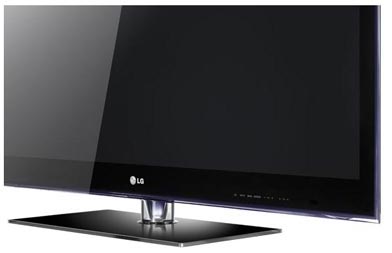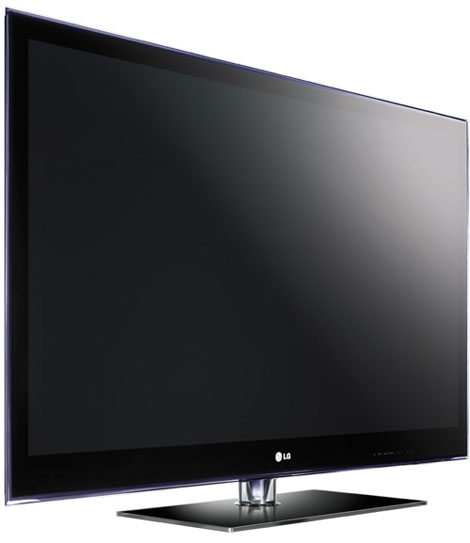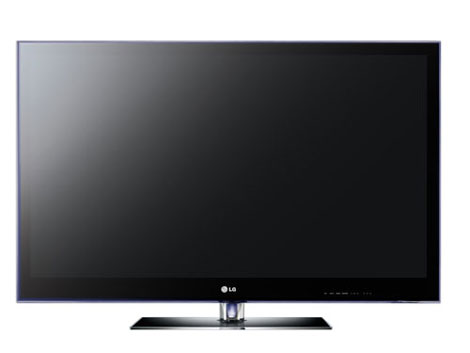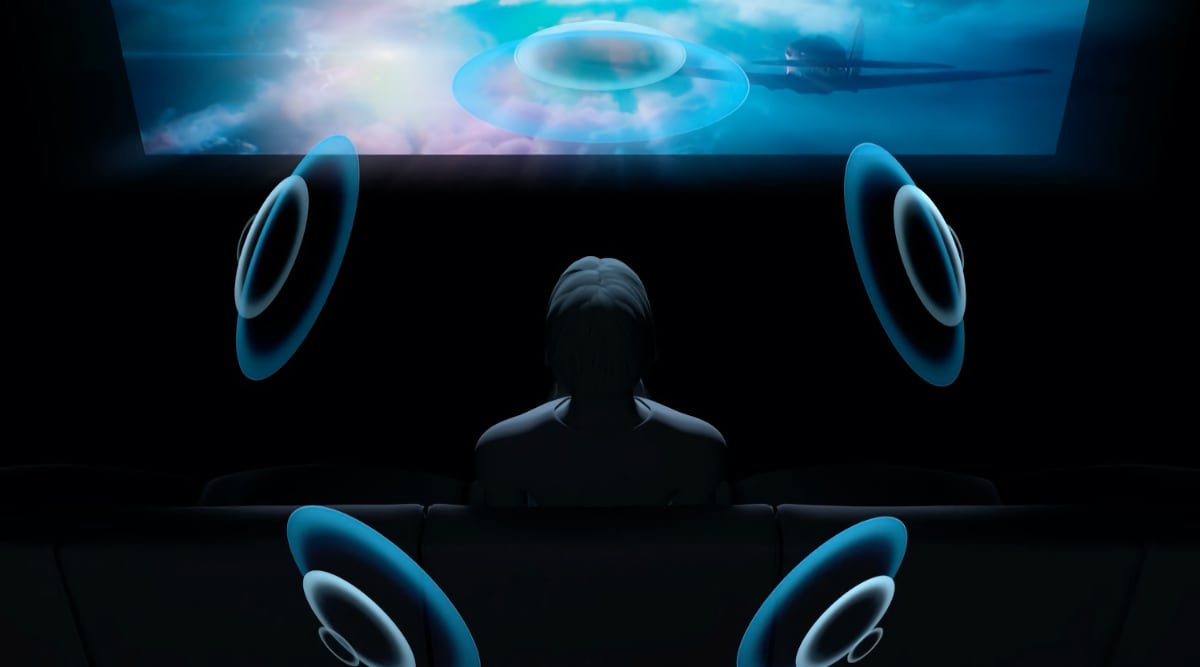LG PK950
LG PK950 review
In this review we will be looking at the brand new LG PK950 which is the new flagship plasma series from LG. PK950 features the Borderless design meaning that the TV has been created from one piece of glass. PK950 also promises great picture quality with a THX mode and a new TruBlack filter than should improve black levels considerably according to LG.
PK950 is the best plasma TV from LG right now and starts at very attractive prices. But can PK950 convince us? And is it a real competitor to the much acclaimed Panasonic plasma TVs? We’ll find out in this review of the 50-inch version called 50PK950.
We have reviewed the European version that similar to the US version except from tuners and inputs. The PK950 series will be available in 50 and 60 inches called 50PK950 and 60PK950. In the UK the PK950 is called PK990.
Subscribe to our Newsletter to receive e-mails when new reviews are online. We’ll soon publish our Sony NX700, Panasonic X20, V20 and VT20 and Samsung C7000 reviews as well.
Pane size: 50" widescreen (plasma) Resolution: 1920x1080 Response time: - Contrast ratio: 5.000.000:1 (dynamic) Brightness: - cd/m2 Colour support: 16,7 million colors Signal processing: 8 bit for each color Viewing angles (H/V): 178/178 Dot pitch: - Panel type: Plasma (LG Display) Wall mounting: Swivel stand: Dimensions (HxWxD): 73.7cm x 119.1cm x 5.3cm (without stand) Weight 30,2 kg Built-in speakers: Input formats: 480p/i, 576p/i, 720p, 1080i & 1080p (50, 60 & 24p) Inputs • VGA • DVI (can be converted through HDMI)
• Audio (type) (Audio in/out)
• SCART (1 input)
• S-video • Composite • Component 
• HDMI (4 inputs)
• Other USB-port + Bluetooth Outputs • Audio (type) (1 output)
• SCART • S/PDIF (optical)
Tuners • Analog • DVB-T • DVB-T (MPEG4) • DVB-C • DVB-C (MPEG4) • DVB-S • DVB-S (MPEG4) • Other
Price and retailer:
| US retailer | UK retailer (PK990 in UK) |
 |  |
Our first impressions
LG PK950 is a part of the Borderless design philosophy from LG. This means that LG has reduced the bezel around the panel and made the entire front of the TV from one piece of glass.It looks good and the choice of materials feels exclusive.
The stand has been made from glass as well. It allows users to rotate the screen.
All inputs are connected on the back of the TV and most of them are pointing backwards towards the wall which is a problem if you want to wall mount the TV with a slim wall mounting solution. LG still hasn’t fixed this. However, I did find some inputs on the side including the 2 USB ports (one for the Wi-Fi dongle) and a single HDMI input.
PK950 is slimmer than the 2009 PS8000 model but still not as thin as the 3 centimeter Samsung plasma TVs.
PK950 has touch sensitive buttons on the front in the lower right side.
Test tools
Our TV signal is DVB-S (satellite) from Canal Digital and DVB-T (terrestrial). We also have an analogue TV connection.Testing is done with the DVE (digital video essentials) and Peter Finzel test DVD. Testing is also done with DVD, TV, Blu-Ray and Mediacenter/PC.
We also use our own monitorTest. The software supports some of the traditional test patterns used to evaluate displays as well as some new and unique test patterns developed by the people here on Flatpanels.
Sony PlayStation 3 is our Blu-Ray player.
Functionality
During CES LG talked about the Magic Remote that should come with PK950 but it seems that only the LX9500 will be getting the Magic Remote. PK950 has this one instead.The TV remote has a glossy black design and large buttons. The many different colors of the buttons makes it appear a bit childish, though.
PK950 has access to NetCast which is a service that connects you to the internet. From here you have access to different content providers and new ones will be added later on. My sample only had access to YouTube, Picasa and Accuweather. I connected PK950 to the internet in Denmark so expect other services in your country.
PK950 also has DLNA functionality that you can find in the My Media section. I tried to connect to the wireless network (with LG's wireless USB dongle) and experienced no difficulties. I just typed my password to my wireless router and 50PK950 connected.
The graphical interface of the DLNA is very appealing but too slow – especially if you want to browse folders with a lot of content such as large photo albums.
Music playback work fine and contrary to Panasonic G20, PK950 actually supports the “brand new” mp3-format.
There are plenty of options when listening to music such as repeat and shuffle. You can also turn of the screen when listening to music. You can even playback your music from either USB, the Internet or DLNA while running a slide show from one of your photo albums.
No problems with photos either. The video support is fair but the menus are too slow. I tried with DivX and mpeg and PK950 did not complain. But MKV was too much for PK950.
PK950 also has some games in the menu such as sudoku.
On the side of PK950 you have two USB inputs. One of them can be used for the wireless USB dongle.
In the video setting menus you’ll find two THX profiles, one for daytime viewing and one for darker environments. PK950 also has two Expert modes with advanced ISFccc calibration options like on the Panasonic G20.
You have access to these picture setting options: contrast, brightness, sharpness, tint, dynamic contrast, noise reduction, black level, film mode, color gamut, edge enhancer, xvYCC, color temperature, and a comprehensive RGB (red, green, blue) menu with both gain (the brightest colors) and sub-brightness (dark colors). Finally, PK950 has a complete CMS menu with saturation and tint controls on 6 primary and secondary colors.
LG 50PK950 has bluetooth that lets you connect to wireless headphones or phones/iPods.
Energy consumption
Measurements on 50PK950 below:| Out-of-Box | After calibration | |
| Standby | 0,0 W | 0,0 W |
| SD | 238 W | 225 W |
| HD | 238 W | 225 W |
After calibration I measured energy consumption of 225 W. This is more than LCD-TVs with LED but better than the PS8000 series from 2009.
Also, please note that the flat panel TV uses less power after calibration. This is common on flat panel displays because many picture parameters are reduced during calibration.
Calibration on PK950
Below you see the out-of-box settings on 50PK950.The graph says this:
The number on the left is the delta value. Delta is a difference between two factors; here it’s the difference between the measured color on the panel and the actual color that is our target.
PK950 does not convince us with its default settings. These are created for shops instead of delivering good and accurate picture quality.
The colors are too saturated and off. This is primarily due to the inaccurate gamma that rises from around 1.7 on bright shades to 2.9 on dark shades. In practice this means that bright colors are too bright and dark colors are too dark.
I now activated the THX mode and did a new measurement.
The result is now much better now, although some colors are still a bit inaccurate. The THX mode is a much better choice although it’s not completely as accurate as on Panasonic G20.
I found a few issues with the THX mode, though. Gamma is not completely accurate and varies from 2.09 to 2.23. We’re aiming for 2.2 tracking on all grey shades. Colours also have a minor yellow push. The THX mode is supposed to be warmer than the other picture modes and this means that colors should be redder/yellower but nevertheless I tried to improve the picture accuracy and will do a full calibration in a sec.
LG incorporated the ISFcc on their 2009 models and they have done the same thing with their 2010 models. This enables the user to configure almost everything, including colors. To access the ISFccc menu you have to use one of the two expert1 and expert2 modes. These picture modes are almost similar to the THX mode but offers more comprehensive picture controls.
As a side note I should probably mention that PK950 has two THX modes; one for daytime viewing and one for darker environments. This is very nice and thank you LG.
Here is what I could manage after a full calibration.
I wasn’t able to perfect the picture but I was able to squeeze a bit more out of PK950. I came closer to our reference of 6500 Kelvin color temperature but I was never able to perfect gamma because PK950 did not allow me to.
Settings after calibration.
| After calibration | |
| Profile: | Expert 1 |
| Contrast | 80 |
| Brightness | 50 |
| Sharpness | 50 |
| Colour: | 50 |
| Tint: | 0 |
| Dynamic contrast: | Off |
| Noise Reduction | Off |
| Gamma | Medium |
| Black level | Low |
| Film Mode | On/Off |
| Colour gamut | Standard |
| Edge enhancer | Off |
| xvYCC | Auto |
| Colour filter | Off |
| Colour Temperature | Warm |
| RGB | |
| Method: | 2 points |
| Pattern: | Outer |
| • Red contrast: | -4 |
| • Green contrast: | 1 |
| • Blue contrast: | 2 |
| • Red brightness: | -7 |
| • Green brightness: | 3 |
| • Blue brightness: | 3 |
I have used the expert1 mode and made a few changes (I didn’t need to change a lot because the expert1 mode uses the same settings as the THX). The main difference and most significant change was my RGB calibration.
You should be able to use these settings on your 50PK950 or 60PK950 but please keep in mind that even TVs in the same range have some minor differences.
Picture quality on PK950
Let me move on to examining picture quality on LG 50PK950 in practice. I’ll also include some comparison to the Panasonic G20 that we reviewed recently.LG has promises that the new TruBlack filter will improve black levels significantly compared to 2009 models, including the PS8000 (that we have reviewed on our Danish site). Black depth was one of the major issues on the 2009 models from LG so I’m pretty eager to examine this (which is done later).
The first thing I noticed on PK950 is the relatively good picture quality. The color reproduction in THX mode is good, although I saw a minor yellow push but I was able to remove it with my calibration. The image is sharp and detailed and one of my first impressions was that PK950 was an improvement compared to PS8000.
PK950 has a glossy glass front and this causes some reflections. With the G20, Panasonic had been able to significantly reduce reflections, but I don’t believe that the PK950 is a real improvement compared to the PS8000 series in this particular area. During daytime a lot of objects and windows are reflecting on the surface of the screen – also a bit more than on the Panasonic X20 that I had on the test bench as well (review online soon).
However, if reflections with other plasma TVs didn’t bother you, reflections on PK950 probably won’t either. PK950 also has the ability to deliver a quite bright picture to compensate.
SD (standard definition) material on PK950 is fair and detailed. You should stick with digital inputs, though.
One of the reasons is the good color reproduction.
De-interlacing on PK950 was also handled nicely. In the menus you’ll find a film mode.
HD looks good, too. PK950 has a detailed HD picture and the motion resolution is high as well ensuring detailed picture in sports and action movies as well.
Remember to put PK950 in the"Just Scan" aspect ratio when you’re using HD sources to avoid scaling.
I did miss the final touch, though, and I feel that PK950 is 100 % not on par with the best plasma TVs out there when it comes to HD reproduction.
The colors are natural. The yellow push on the THX mode could be corrected with a calibration in the advanced menus on PK950. The yellow push is not critical at all and I feel that color decoding and color reproduction in practice (when you also consider the plasma panel and the actual visible result) is nice. I did experience that some of the darkest colors had a tad of red in them and that not all very dark colors were distinguished correctly, though.
Plasma panels have a tendency to introduce the so-called"banding," which means that for example a picture of the sky changing from dark blue at the top to lighter bluish hue in the horizon, might look like it’s divided into"steps" instead of being smooth. This phenomenon occurs because the plasma panels “mix” certain colors to create new ones using a so-called"dithering" process.
For example plasma panels cannot not natively reproduce dark grey so in order to display that color, the panel is alternating between black and lighter shades to create an illusion of a different color.
PK950 has no serious banding, and a bit less than the G20, but it’s there.
Another thing that I noticed with the PK950 is that the picture is not as stable as on G20. The plasma technology “adjusts” brightness depending on what you see on the screen. Take for example a white circle that only takes up about 10 % of the screen area, and it will appear much brighter (thus white) than if the entire screen was dominated by white.
I’m talking about APL (average picture level). PK950 varies slightly more in image brightness and color intensity depending on the content on the screen compared to Panasonic G20. It is not critical but you can see if it you it’s there.
I also examined response time on PK950. Plasma TVs have faster response time than LCD-TVs but are also struggling with phosphor trailing. Most of the time you’ll see phosphor trailing as a yellow, green or red tint behind or in front of moving objects, such as football or a football player.
In regards to phosphor trailing PK950 is doing quite good and I’m impressed.
PK950 has a very quick response time and phosphor trailing is barely visible. PK950 is actually beating G20 in regards to phosphor trailing because LG has been able to reduce it even further than Panasonic. Phosphor trailing has not been eliminated on PK950, though.
I’m sure a lot of you sports fans and gamers out there will appreciate this.
Input lag is also quite low.
For some years LG has been having problems with retention (temporarily burn-in). PK950 also has some retention issues and this is a shame. I experienced retention with for example the PlayStation 3 music screen but also saw a bit of retention with some channel logos.
On the picture above PK950 had been playing music from the PlayStation 3 for about 1-2 hours with the small music indicator in the bottom left corner.
Nevertheless, retention is still a problem on the LG plasma TVs. The same is true for Samsung. Only Panasonic has been able to eliminate retention (at least almost).
I went on to measure the reproduction of black that I was eager to examine because of the new TruBlack filter. Below you can see what I measured.
| Out-of-Box | After calibration | |
| Black level | 0,05 cd/m2 | 0,04 cd/m2 |
| Brightness | 142 cd/m2 | 73 cd/m2 |
| Contrast ratio | 1840:1 | 1825:1 |
Contrast ratio +/- 50
After calibration I measured a black level of 0.04 cd/m2 which is the same as Panasonic G20 but a fairly significant improvement compared to the PS8000 plasma series from 2009 that we measured to 0.12 cd/m2.
This is a significant improvement by LG that now has the same deep black levels as on the Panasonic plasma TVs. And that’s certainly reason for excitement.
During daytime black levels on the PK950 are reduced a lot, though, because of the reflections in the panel and on the glass front. Panasonic G20 had very good anti-reflective capabilities which also ensured proper daytime viewing capabilities. Due to the reflections on PK950 black is reproduced as dark gray in heavy ambient light environments but in the evening PK950 has nice and deep black levels.
Shadow detailing is convincing as well, although not perfect. The 1-2 darkest shades of gray are reproduced as completely black. But nevertheless, the overall shadow detail performance on PK950 is good.
Finally I have taken a picture of PK950 in a completely dark room to examine clouding issues and to demonstrate the black level.
LG 50PK950 have no clouding issues.
PC and media centre
In order to get 1:1 pixel mapping just make sure to output a resolution of 1920x1080 and put the PK950 in the"Just Scan" aspect ratio.Viewing angles
Plasma TVs has wider viewing angles than LCD-TVs. PK950 is no exception and the viewing angles ensures that color intensity is maintained from angles. The contrast does not change much from angles, either.Unfortunately, PK950 has problems with reflections from the front glass. The Panasonic G20 model had been able to reduce reflections effectively so I had hoped that LG had managed to do the same.
I see some in-panel reflections on PK950 but it has certainly been reduced compared to previous LG plasma TV but I still see a mirror effect between layers that you can also see on the picture below. This means that colors on PK950 loose intensity and the picture has reduced contrast during daytime, because reflections are entering the panel rather than simply glancing off on the outer glass front.
Because of the small gap between the glass front and the plasma panel reflections makes picture look blurry from 75-90 degree angles as well but this is not a serious problem because you’ll never experience it from the front.
Sound
Sound quality is not impressive and I didn’t expect anything unique. Manufacturers are releasing thinner and thinner TVs with hidden speakers and obviously this means there’s not much space for proper speakers.PK950 has a Clear Voice feature which ensures that human voices are enhanced and this is a plus but PK950 lacks bass and treble.
Especially the deep bass tones are very weak and I recommend a separate audio system with PK950.
Conclusion
With the PK950 series LG has created a TV based on the Borderless design philosophy, from one piece of glass. The choice of material is elegant and the glass front, too, although it does cause some reflections.This year LG has managed to improve reproduction of black significantly compared to their 2009 models, and I measured the same black level on PK950 as I did with the Panasonic G20. The THX mode also delivers accurate and lifelike colors, but it’s not perfect. Response time and motion resolution is well handled by PK950 and phosphor trailing has been reduced to a minimum.
Unfortunately, PK950 still has some retention issues, which is a shame.
PK950 has some nice functionality as well. I was able to playback most content from the USB input and DLNA, but I could not playback MKV. The DLNA menus are slow, too, but besides that the media functionality on PK950 is very good. The NetCast function that gives you access to the internet, on the other hand, has too few services (at least in our country).
Also, inputs and outputs are still facing towards the wall.
Pricing on the PK950 series is very attractive and LG wants to launch a 50 and 60 inch model. I see the PK950 as a very good alternative for good picture quality at a very reasonable price. And even though it’s not setting new standards for picture quality and struggles with some minor retention, I think LG has taken a huge step in the right direction with PK950, and PK950 receives our Top Recommendation Award.

Press the award logo to learn more.
We have reviewed the European version that similar to the US version except from tuners and inputs. The PK950 series will be available in 50 and 60 inches called 50PK950 and 60PK950.
Subscribe to our Newsletter to receive e-mails when new reviews are online. We’ll soon publish our Sony NX700, Panasonic X20, V20 and VT20 and Samsung C7000 reviews as well.
| Pros | Cons | Target group |
| Good picture quality | Retention | Living room |
| Deep black levels | Reflections | Home Cinema |
| Price | Not competing with the best plasma-TVs out there | |
| THX mode | Dimmer and more “dead” picture during daytime | |
| Functionality, DLNA, bluetooth mm. | Slow DLNA, only a few NetCast services, inputs facing backwards | |
| Viewing angles |
Price and retailer:
| US retailer | UK retailer (PK990 in UK) |
 |  |
LG PK950 discussion
For questions and comments please visits this thread in our forums:http://www.flatpanelshd.com/flatforums/viewtopic.php?f=5&t=2013
For further information and reviews of this product please visit TestFreaks














